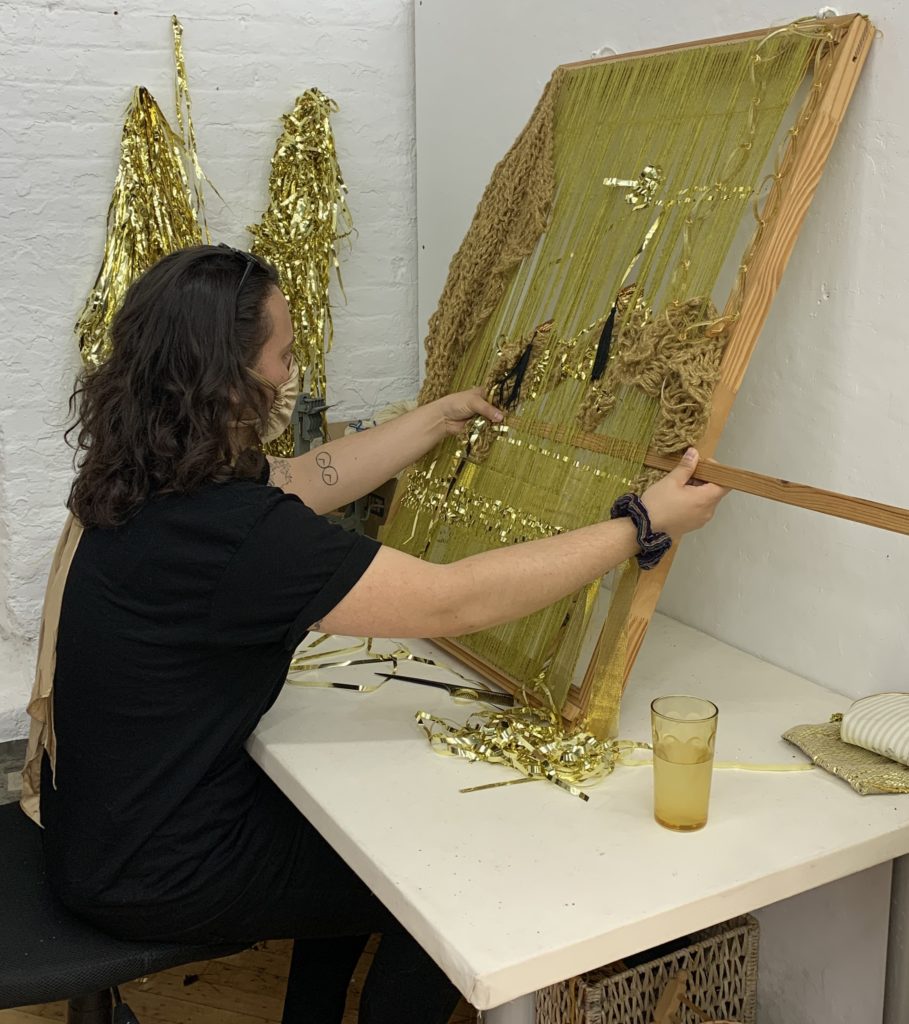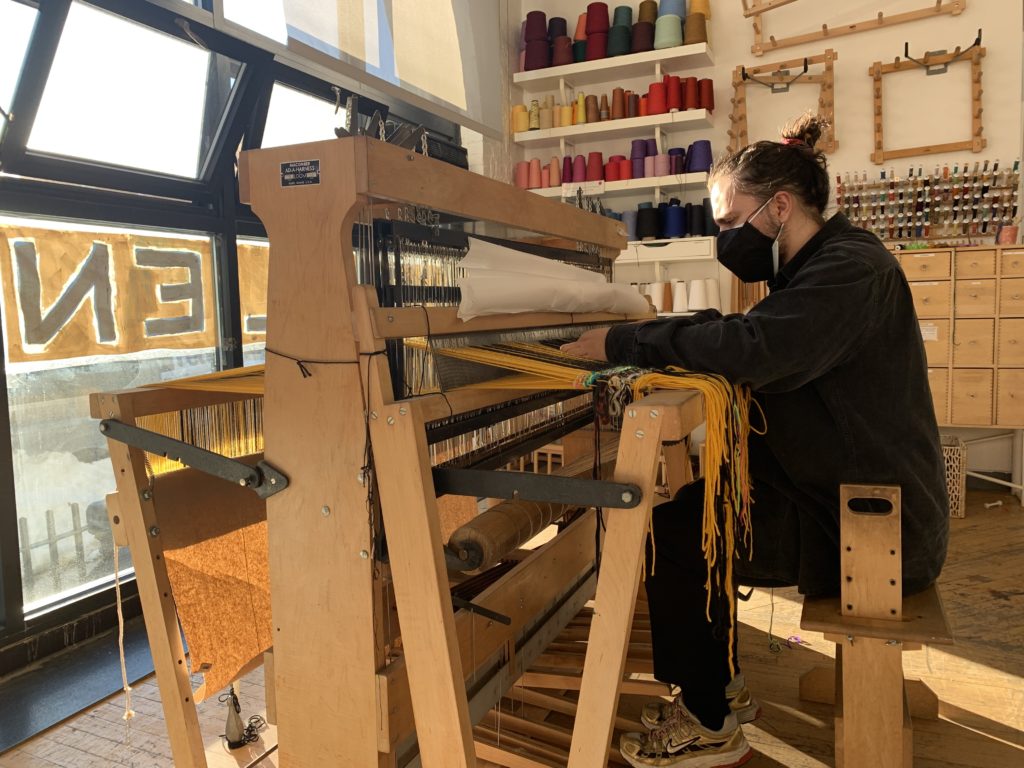AIR Highlight: Francisco echo Eraso
This conversation took place on June 28, 2021 at the Textile Arts Center with Francisco echo Eraso and Isa Rodrigues
Video Visual Description:
Footage of echo, a white Latinx trans person with their long hair down, wearing a black face mask, gold spiral earrings and a black tank top against a white wall covered with his golden textile art. In the foreground on the right hand side is the blurry silhouette of Isa’s light face and dark curly hair and her gold hoop earring. Some points of the video span around textiles as they are described in the background and some points are interspersed with some footage of echo weaving on a frame loom in his studio.
Francisco (echo) Eraso (he/él) is a disabled, queer, trans, Colombian-American textile artist, writer and performer. echo’s work makes evident the construction of value through reproductions of gold and allusions to textiles as a form of currency. In his woven textile installations, experimental video work and somatic movement practice he patches together the interrelated legacies of extractive capitalism, ornamentation, labor, alchemy, healing and repatriation.
echo is a Cycle 12 Artist in Residence at the Textile Arts Center and Art and Disability Residency in New York and an upcoming Artist in Residence at 77Art in Vermont. He has received a BA/BFA in Visual Studies and Fine Arts from Parsons, The New School. His work has been presented at a variety of venues including The Flux Factory, Franklin Street Works, Amos Eno Gallery, The Sheila C. Johnson Gallery among others. echo currently lives in Unceded Canarsee Lenapehoking aka Brooklyn, New York and works as the Administrative Assistant for the Disability Futures Fellowship at the Ford Foundation.
Isa Rodrigues (she/her) is the co-Executive Director of the Textile Arts Center
Isa: Hi echo, I’m really happy to be in conversation with you today about your practice and about your experience here at TAC, would you like to start by introducing yourself?
echo: Hi Isa, thank you. I’m Francisco echo Eraso and my pronouns are he/him. I’m a current Artist in Residence here at TAC and my art focuses a lot on gold and the construction of value and using textiles as a means to point to historical modes of currency.
Isa: When did you start working on textiles? Can you speak a little bit more on what drew you to work with fiber materials and techniques?
echo: So, when I was young, very young, my great grandmother taught me how to knit and crochet. And over time I started using those forms for installations and sculptures that felt more intuitive and true to my experience and practice than painting, which I did a lot of growing up. And more recently, I have taken to more textile based processes than knitting and crochet as well such as weaving, screen printing, felting and sewing a little bit.
Isa: It’s been really great to see how you also embed your concept and research within all these techniques. And I’m thinking also particularly about when you were taking a garment weaving class at TAC with me and I’m just looking at the piece that you created during that class and you had such a painterly approach. And also this deep concern about your material choices. It was all very intentional. Can you speak a little bit about that and I guess the role of weaving in your practice too?
echo : so that class, the weaving I made in that class I’m still actually working on and was the second woven piece I made on a floor loom particularly. I remember wanting to incorporate gold, and because I couldn’t find enough gold yarn, I ended up using this leftover recycled black linen that paired so well with the gold that I could find. That was a whole fiasco in learning how to warp my yarn and making this huge knot. I don’t know if you remember [laughs] that took a week just to unwrap the warp knot that I made and was really adamant that it didn't go to waste. I think that’s also a really big part of my practice, mixing found and recycled materials in particular and always something golden.
Isa: Was that approach something that you have done in previous work? The concern about sourcing the materials, the concern about recycling or upcycling?
echo: Yes, so the one weaving I had tried before that, a friend of mine had lent me a Saori loom and I remember only wanting to use handspun materials as I was starting to learn that process. Most of that was hemp and wool that I sourced while I was traveling through Colombia with my tío and learning more about textiles there and learning about the kind of different political landscapes as they related to these really beautiful iconic Colombian textiles. That has been a big part of my process in many ways.
Isa: echo, can you speak more about what has been the focus of your research and studio practice over the last nine months while in residence here at TAC?
echo: yeah, thank you for that question. In the fall and winter I started to do a lot of research on the Red Cross, La Cruz Roja in Colombia. In about late October, my grandfather passed away and one of his living legacies has been instituting the Red Cross in Southern Colombia and using that research to connect with him and his life. I ended up creating a few weavings based on that research. That quickly turned into a larger political landscape. Or fell, rather into a larger political landscape with the protests in Colombia and the ongoing medical crisis as it relates to Covid-19. Thinking about all of that in relation to my ongoing research practice with Gold and all that has come to represent. In particular as it relates to Colombian national identity and colonial history. I find it can also relate to so many things especially in this material, playful way in my work.

Isa: Can you speak a little bit about the importance of gold in your practice? The way it comes in different forms. I’m looking at the gold screenprints behind us, the gold yarn on the ruana and the other weaving. It is this common element and thread within your work.
echo: Gold has become a stand-in for everything and anything. Like I said, as it relates to colonial history in Colombia maybe even extending to the present day with a lot of instances of the results of American imperialism. Also I think what’s so interesting about gold is the reason I find it so popular in a kind of narrative of Colombian identity is that it starts with these Indigenous artifacts. I’m so curious how those are displayed in museums, held almost captive, and defining value and worth in a lot of ways. So, I’ve explored these general ideas as they relate to the topics in my individual pieces.
For the Ruanas, I was exploring a particular Colombian textile that has become a symbol of national patrimony and kind of putting it in conversation with this larger research topic of Gold. Also the Ruana that I’m working on right now, is a part of a larger series. I’ve woven that in gold to really make those connections clear. And I’m working on a silk lining (for it) that I’m printing, as you mentioned. Experimenting with screen printing for the first time here at TAC, actually, which is very frustrating and also fun. (laughs) Those screen prints have come to me as my last minute, last project here (at TAC residency) overlapping all these different kinds of maps to create a kind of camouflage effect to point again to these historical references and using beautiful glamorous gold and these metallic inks has also been a big part of that.
Isa: echo, you spoke a little bit about some of the techniques that you got to learn and experiment with at TAC. Can you speak a little bit more about your experience as an Artist in Residence while in the program and if there are any highlights of the 9 month experience?
echo: I actually started off at TAC in general by teaching in the summer camp 2 years ago and taking your class as I said. TAC has just felt like a really present community space for me as it relates to textiles and other people that are just very excited about fiber but through the residency in particular there wasn’t anyone around. So there’s usually kids running around with the classes, other adults coming in for the studio space. It was so focused to be just the 8 of us and Isa and Kelly or another studio renter. It was really sparse and we were able to spread out a lot in a really unique way because of Covid.
We really got along so well! I hadn’t seen other people in person for almost a year and I think that really created a lot of magical moments between us as residents. (We were all) excited to see other people, and talk about art, and make art again, and also feel safe while doing that. Everyone had to wear their masks. I’ve been very very paranoid about Covid in so many ways, for what happened with my grandfather, for myself, and all my disabled and sick friends. And so as things are reopening I think that’s something that I’ll hold dear to me, being able to feel excited to be in space together and not have to worry about safety as much as I think it’s probably going to continue happening as things continue to change. So that was really unique and special.

Isa: As we start preparing for the final exhibition in September which will be the culmination of these last 9 months. We’ve been talking about exhibition layout and narrative, can you share a little bit about your plans for what you’ll be presenting?
echo: A little bit! I think as I’m starting to work towards a final piece to present, it’s become more apparent to me that everything is coming so spontaneously. The projects that I’m able to work on are coming to me really intuitively, which I think I’ve learned from other residents here to just go with it. Which is really magical and lovely. So, it will be gold, it will be woven and I’m really excited to do hopefully something more performance based now that we have a space together and some time for programming in that public facing way. But beyond that I think I still have a lot of decisions to make.”
Isa: echo, are there any upcoming or current projects or plans for after the residency that you’d like to share?
echo: Yes, I’m actually selling a collection of mini golden textiles through Queer Arts Pride Marketplace, that will be up until the end of July. Half of the proceeds from all of those items is going to Red Comunitaria Trans, which is a small organization in Colombia that is run by trans people and sex workers, most of them are on the front lines in the current protests in Colombia and just generally need support. On the horizon, I’m excited to have another residency in Vermont through 77Art. The Director I actually met at TAC as well. Everything feels very connected.
Isa: It’s all coming full circle. Thank you for sharing, echo and congratulations on your next residency. I can’t wait to see the final exhibition.
The TAC AIR 12 Final exhibition, Considering Mass and Density, will be on view at the Textile Arts Center from September 13-26, 2021.